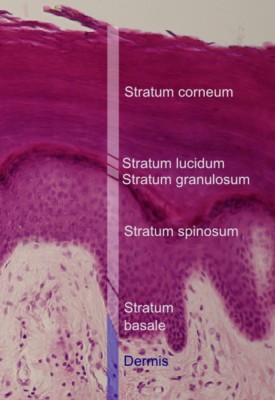**_What is the largest organ in the human body? That’s easy to answer–the skin, also known as the epidermis – your body’s hairy, breathing, secreting, self-generating, shedding, swelling, permeable and adaptive outer envelope.
Just a single square inch of skin contains 3 primary layers, 11 miles of blood vessels, 650 sweat glands, 60,000 melanin-maker cells, and over 1,000 nerve endings.

Photo credit: Kerela Tourism
The skin is the major organ in the integumentary system, one of eleven major human organ systems comprising 78 distinct organs. Our flesh represents some seriously sophisticated, all-natural biotechnology for advanced animals. It has to be able to keep the good stuff coming in and the bad stuff out, which is no easy task.
Pound of Flesh
The soft outer envelope of the skin evolved to cover vertebrates; it’s what we have instead of a stony exoskeleton. As the biggest organ for mammals in general, our skin is the heaviest organ and has the largest surface area.

Epidermal layers (Photo credit: Mikael Haggstrom)
An adult’s dermal layers collectively weigh from six to eight pounds–about twice as hefty as either the brain or the liver. The liver weighs in at between three and four pounds, making it the second largest and heaviest organ in the human body. Keep in mind that your skin is an external organ, giving the liver the number one spot as far as internal organs are concerned.
More Than One Way To Skin a Cat
One of the skin’s most crucial jobs is protection of all that goes on underneath it. It must preserve moisture, regulate internal temperature, defend against harmful chemicals and bacteria, and act as the primary sensory interface between you and the environment.
You excite your lover with it, and offend still others with its pungent smell. You bemoan its wrinkles, pimples and stretch marks, and delight in damaging the surface with a nice suntan. The skin makes us moist when we are dry, cool when we are hot, and gives us cancer when we are negligent. Skin makes the rest of our body work right, yet we hardly notice its importance.
Bonus Facts To Arouse Your Curiosity###
The Skinny on Skin CancerSkin is not meant to tan. A suntan is a symptom of damaged skin. Skin cancer is the most common type of cancer in the U.S. Over 2 million Americans have to deal with this epidemic disease every year, and the rates are still growing, despite the fact that skin cancer is overwhelmingly preventable.
The two best ways to ward off skin cancer are by not smoking and by vigilantly wearing sunscreen that contains the ingredient zinc. Zinc is the magic bullet that protects against every kind of solar radiation, including UV rays.
Stretch Marks Fact and Fiction
People who lose weight or go through pregnancy, with few exceptions, cannot simply diet away the extra skin that stretched to accommodate the former load. Many weight loss promoters try to convince consumers stretch marks can be reversed or avoided if a certain product or weight loss regime is followed, but this is misleading and usually false advertising.
Why, you might ask? It has to do with elasticity, the only variable you can really impact is how slowly you lose or gain weight. A slower pace of is generally better. Past a certain point of expansion, however, elastic fibers inside the skin break under pressure, and the damage is usually permanent. It’s better to save your money and learn to love those stretch marks.
Winning the Lotto
Strangely, the largest organ in the body is also one of the biggest sources of air pollution. Dead skin accounts for a billion tons of dust in the global atmosphere. It’s the top cause of household dust. That’s because your skin sheds 50,000 cells every minute.
In the world of microorganisms, this is like winning the lotto. Your skin is its own microbiome, hosting hundreds of millions of microbes of over one thousand species, including the Staphylococcus bacteria, which feast on this daily dust storm. But don’t panic–most of these organisms are either neutral to your health or even benefit you, assuming proper hygiene.